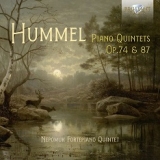Elisabeth Smalt, Bratsche, Jan Insinger, Violoncello, Pieter Smithuijsen Kontrabass); 1 CD Brilliant Classics 96901; Aufnahme 2006/2009
Veröffentlichung 14.07.2023 (61'08) - Rezension von Remy Franck
1802 begründete Johann Nepomuk Hummel (1778-1837) mit seinem Quintett es-Moll op. 87 aus dem Jahre 1802 die damals ungewöhnliche Gattung des Quintetts mit Klavier, Violine, Viola, Violoncello und Kontrabass, und diese Partitur gilt als eines seiner Hauptwerke. Obwohl es hinsichtlich der Kompositionszeit Unklarheiten gibt, soll das das Quintett op. 74 erst 1816 entstanden sein.
Beide Werke realisieren einen sehr schönen und angenehmen Austausch zwischen dem Klavier und den Streichern, sie sind melodisch, oft von erhabener Anmut, hin und wieder auch recht dramatisch.
Die beiden qualitativ hochwertigen Kompositionen werden vom Nepomuk-Fortepiano Quintet gut umgesetzt. Sie benutzen dafür historisches Instrumentarium mit Darmsaiten und ein gut klingendes Pleyel Fortepiano von 1842. Sie geben Hummels Werken alles, was sie an Charme und Phantasie brauchen, um attraktiv zu werden.
In 1802 Johann Nepomuk Hummel (1778-1837) founded the then-unusual genre of the quintet with piano, violin, viola, cello, and double bass with his Quintet in E-flat minor, Op. 87, and this score is considered one of his major works. Although there is some ambiguity as to the time of composition, the Op. 74 quintet is thought to have been composed as late as 1816.
Both works realize a very beautiful and pleasant exchange between the piano and strings; they are melodic, often of sublime grace, now and then also quite dramatic.
The two high-quality compositions are well performed by the Nepomuk Fortepiano Quintet. They use period instruments with gut strings and a good-sounding 1842 Pleyel fortepiano for this, giving Hummel’s works all the charm and imagination they need to be attractive.
























